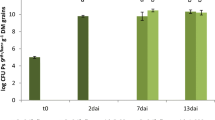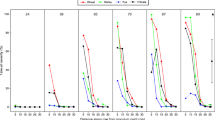Summary
Mated cultures of Blakeslea trispora, which produce trisporic acid, inhibited root and shoot extension of barley plants grown in gnotobiotic cultures, where the carbon from roots was the sole source of carbon available to the microorganism. Unmated cultures of B. trispora and Mucor hiemalis, which do not synthesize trisporic acid, inhibited root extension only. Azotobacter chroococcum had a variable effect in different experiments on both root and shoot extension but could at least partially relieve the inhibitory effect of B. trispora on root growth. Plant growth regulators, applied to roots exogenously, produced effects on plants which, although comparable with some of the inhibitory effects of the micro-organisms, were not comparable with the stimulatory effects of A. chroococcum. re]19751127
Similar content being viewed by others
References
Anderson J. P. E. and Domsch K. H., Quantification of bacterial and fungal contribution to soil respiration. Arch. Mikrobiol. 93, 113–127 (1973).
Austin D. J., Bu'Lock J. D. and Gooday G. W., Trisporic acids: sexual hormones from Mucor mucedo and Blakeslea trispora. Nature 223, 1178–1179 (1969).
Barber D. A., The effect of micro-organisms on the absorption of inorganic nutrients by intact plants. I. Apparatus and culture technique. J. Exp. Bot. 18, 163–169 (1967).
Barber D. A. and Martin J. K., The release of organic substances by cereal roots into soil. New Phytol. 76, 69–80 (1976).
Brown M. E., Plant growth substances produced by micro-organisms of soil and rhizosphere. J. Appl. Bacteriol. 35, 443–451 (1972).
Brown M. E., Seed and root bacterization. Annu. Rev. Phytopathol. 12, 181–197 (1974).
Brown M. E., Burlingham S. K. and Jackson R. M., Studies on Azotobacter species in soil. III. Effects of artificial inoculation on crop yields. Plant and Soil 20, 194–214 (1964).
Brown M. E. and Burlingham S. K., Production of plant growth substances by Azotobacter chroococcum. J. Gen. Microbiol. 53, 135–144 (1968).
Bu'Lock J. D. and Winstanley D. J., Trisporic acid production by Blakeslea trispora and its promotion by barbiturate. J. Gen. Microbiol. 69, 391–394 (1971).
Collocott T. C. Dictionary of Science and Technology. W. & R. Chambers Ltd., Edinburgh (1971).
Domsch K. H., The action of physiologically active substances in the root region. In Plant Microbes Relationships, pp. 201–208. Edited by J.Macura and V.Vančura. Prague: Czechoslovak Academy of Sciences (1965).
Domsch K. H. and Gams W., Die Bedeutung vorfruchtabhängiger Verschiebungen in der Bodenmikroflora. I. Der Einfluss von Bodenpilzen auf die Wurzelentwicklung von Weizen, Erbsen und Raps. Phytopathol. Z. 63, 64–74 (1973).
Domsch K. H. and Gams W., Fungi in agricultural soils. London: Longman (1972).
Feofilova E. P., Lozhnikova V. N., Bekhtereva M. N., Samokhvalov G. I. and Chailakhian M. Kh., The influence of trisporic acids on the growth, pigment formation and respiration of pea sprouts. Dokl. Akad. Nauk SSSR 208, 483–486 (1973).
Kenneth J. H., A dictionary of scientific terms. 7th edn. Edinburgh: Oliver and Boyd (1960).
Leelavathy K. M., Effect of some common rhizosphere fungi on root growth of seedlings. Plant and Soil 30, 335–338 (1969).
Lynch J. M. and Harper S. H. T., Ethylene formation by a soil fungus. J. Gen. Microbiol. 80, 187–195 (1974).
Marchant R., The root surface of Ammophila arenaria as a substrate for micro-organisms. Trans. Br. Mycol. Soc. 54, 479–482 (1970).
Mehrotra C. L. and LehriL. K., Effect of Azotobacter inoculation on crop yield. J. Indian Soc. Soil Sci. 19, 243–248 (1971).
Merriman P. R., Price R. D. and Baker K. F., The effect of inoculation of seed with antagonists of Rhizoctonia solani on the growth of wheat. Aust. J. Agric. Res. 25, 213–218 (1974).
Merriman P. R., Price R. D., Kollmorgen J. F., Piggott T. and Ridge E. H., Effect of seed inoculation with Bacillus subtilis and Streptomyces griseus on the growth of cereals and carrots. Aust. J. Agric. Res. 25, 219–226 (1974).
Mishustin E. N., The importance of non-symbiotic nitrogen-fixing micro-organisms in agriculture. Plant and Soil 32, 545–554 (1970).
Otto G., The influence exerted by fungi in the rhizosphere on the density of ramification of Cucumber roots. In Plant Microbes Relationships, pp. 209–219. Edited by J.Macura and V.Vančura. Prague: Czechoslovak Academy of Sciences (1965).
Parkinson D., Techniques for the study of soil fungi. Bull. Ecol. Res. Comm., Stockholm 17, 29–36 (1973).
Pidoplichko N. M., Moskovets N. S. and Zhdanova N. N., Influence of some fungi from the maize rhizosphere on the growth of its seedlings. In Plant Microbes Relationships, pp. 220–227. Edited by J.Macura and V.Vančura. Prague: Czechoslovak Academy of Sciences (1965).
Patel J. J., Micro-organisms in the rhizosphere of plants inoculated with Azotobacter chroococcum. Plant and Soil 3, 209–223 (1969).
Remacle J., Evolution d'une population d'Azotobacter chroococcum dans la rhizosphere de l'orge en presence d'un Bacillus pectinolytique. Ann. Inst. Pasteur Paris 111, 149–154 (1966).
Remacle J., Mixed culture of micro-organisms in the rhizosphere of ivy (Hedera helix L.). Plant and Soil 36, 199–203 (1972).
Remacle J. and Rouatt J. W., Culture mixte de Azotobacter chroococcum et de germes pectinolytiques dans la rhizosphere de l'orge. Ann. Inst. Pasteur Paris 115, 545–754 (1968).
Ridge E. H. and Rovira A. D., Microbial inoculation of wheat. Transactions of the 9th International Congress of Soil Science, Adelaide 3, 470–481 (1968).
Smith K. A. and Robertson P. D., Effect of ethylene on root extension of cereals. Nature 234, 148–149 (1971).
Spalla C. and Biffi G., Abscisic acid-like activity of trisporic acids. Experientia 27, 1387–1388 (1971).
Srivastava V. B., Effect of some rhizospheric fungi on seedling growth. An. Edafol. Agrobiol. 31, 787–789 (1972).
Tchan Y. T. and Jackson D. L., Studies of nitrogen fixing bacteria. IX. Study of inoculation of wheat with Azotobacter in laboratory and field experiments. Proc. Linn. Soc. N.S.W. 90, 290–298 (1965).
Youssef Y. A., Studies on the rhizosphere microflora of broad bean and cotton. Effect of fungal filtrate on plant growth. Folia Microbiol. 19 381–385 (1974).
Author information
Authors and Affiliations
Rights and permissions
About this article
Cite this article
Lynch, J.M., White, N. Effects of some non-pathogenic micro-organisms on the growth of gnotobiotic barley plants. Plant Soil 47, 161–170 (1977). https://doi.org/10.1007/BF00010377
Received:
Issue Date:
DOI: https://doi.org/10.1007/BF00010377




